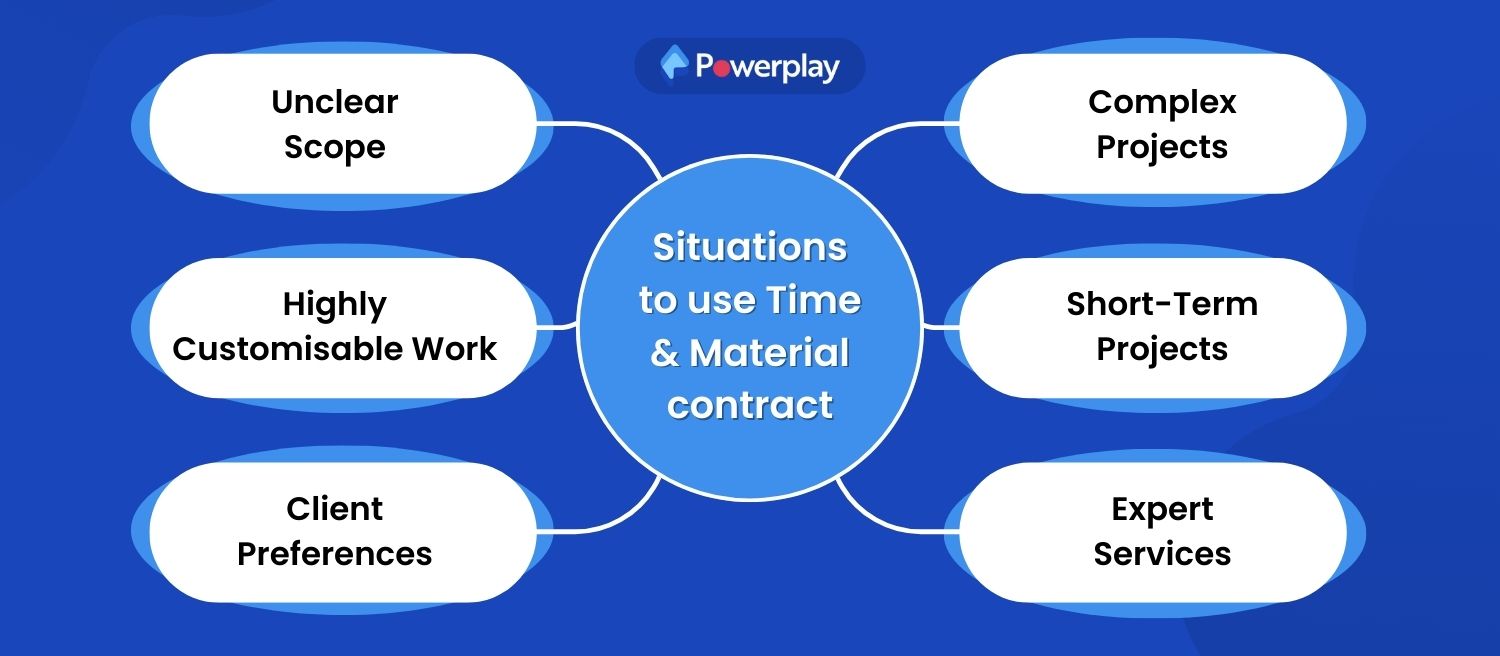Time and Materials (T&M) Contracts in Construction: Guide for Contractors & Project Owners
-
Sapna
- May 7, 2024

Accurately estimating the cost of construction projects is fraught with challenges. Overestimate, and you risk losing the bid to competitors; underestimate, and you might face significant financial losses. Factors such as fluctuating material costs, labour availability, and unexpected regulatory changes can drastically alter the project’s budget mid-course.

Many contractors turn to Time and Material (T&M) contracts to navigate these uncertainties. These contracts offer the flexibility to adjust to actual expenses incurred, providing a practical solution to manage the inherent unpredictability of the construction industry.
Table of Contents
ToggleWhat is a time and material contract?
A time and material contract is commonly used in construction and other project-based industries. In this contract, the client agrees to pay the contractor based on the time the contractor’s employees and subcontractors spend performing the work and for the materials used in the project.
Under a time and material contract, the payment is typically made at agreed-upon hourly or daily rates for labour plus the cost of materials. This cost may include a markup. This type of contract, known for its flexibility, is often used when the project’s scope still needs to be fully defined or is expected to change. It empowers contractors to manage labour and materials efficiently, while the client must closely monitor the progress and cost to avoid budget overruns.
How Do Time and Materials Contracts Work?
Time and materials (T&M) contracts are agreements where the client pays the contractor based on the project’s employees’ actual time and materials spent on the project. The contract specifies hourly or daily rates for labour and how materials costs will be calculated, typically including a markup.
Contractors must maintain detailed records of labour hours and material usage, periodically submitted to the client as invoices. These contracts are preferred when project scopes are uncertain or likely to change. They provide flexibility, but the client’s vigilant oversight is crucial to managing costs and ensuring project alignment, making them feel involved and responsible.
When Should You Use a Time and Materials Contract?
A time and materials (T&M) contract is particularly suitable in scenarios where the scope of a project is not clearly defined or is subject to change. Here are some specific situations when you might consider using a T&M contract:

- Unclear Scope: When the project’s full scope cannot be accurately defined at the outset, a T&M contract allows flexibility to accommodate changes or unexpected tasks without needing to renegotiate the contract.
- Complex Projects: T&M contracts can benefit projects involving complex work, where problems and solutions may only become apparent as work progresses. This is common in software development, research and development, and specialised construction industries.
- Highly Customisable Work: Projects that require customisation based on client feedback throughout the execution phase benefit from T&M contracts. This setup allows for iterative reviews and modifications without financial penalties or extensive renegotiations.
- Short-Term Projects: For short-term engagements where it is easier to monitor the work and costs directly, T&M contracts can provide a straightforward contractual basis without the detailed forecasting required for fixed-price contracts.
- Client Preferences: Some clients may prefer T&M contracts for projects where they want more control over the work process and the ability to adjust requirements based on evolving needs or insights gained during project implementation.
- Expert Services: When the work involves specialised expertise that does not lend itself well to quantification in advance, such as consulting services, legal advice, or emergency repairs, a T&M contract ensures that the service provider is fairly compensated for the actual work performed.
What Should Be Included in a Time and Materials Contract?
A Time and Materials (T&M) contract should include several components to ensure clarity and fairness for both parties. It should specify the hourly or daily rates for labour, including rates for different types of labour, if applicable. The contract should also detail the cost of materials and whether there’s a markup on these costs. It is also better to include a not-to-exceed clause, which can be beneficial to cap total expenses.
Additionally, the contract should outline the project scope and specific terms for reporting time and expenses, ensuring regular updates and transparency. Provisions for handling unexpected changes or additional requirements, as well as final invoicing and payment terms, should also be included to manage the project effectively.
Parts of a Time and Materials Contract

A Time and Materials (T&M) contract is designed to provide flexibility in managing projects where the scope is not completely defined while ensuring that all costs are covered and a fair profit margin is achieved for the contractor. Typically, this type of contract includes several critical components:
- Labour Rates: Defines the hourly or daily fees for workers, which may vary by skill level or role.
- Maximum Labor Hours: Caps the number of hours billed to prevent budget overruns and ensure project efficiency.
- Materials Markup: Specifies the percentage added to the cost of materials to cover handling and procurement, contributing to the contractor’s overhead and profit.
- The Time and Materials Not-to-Exceed Clause (T&M NTE) limits the total expenditure to a set amount, protecting the client from excessive costs and encouraging efficient work.
- Payment Milestones: Establishes specific points in the project timeline at which payments are due, based on progress or completion of defined phases.
Additional Items to Consider for a Time and Materials Contract
When drafting a Time and Materials (T&M) contract, additional considerations should include detailed record-keeping requirements to ensure transparency and accountability for hours worked and materials used. Provisions for handling changes in scope, which should detail how adjustments to the contract will be negotiated and approved, are also vital.
Furthermore, including audit rights can be beneficial, allowing the client to verify charges reflected on invoices. Lastly, setting clear terms for dispute resolution and contract termination helps manage any disagreements or changes in project viability efficiently. These elements ensure both parties understand their rights and responsibilities clearly, leading to smoother project execution.
Advantages and Disadvantages of Time and Materials Contracts
Time and Material (T&M) contract can be quite effective in certain project scenarios, especially where the scope is not clearly defined from the start. Here are some of the key advantages and disadvantages of using T&M contracts:

Advantages
1.Flexibility:
T&M contracts offer flexibility in managing project scopes that are not well-defined or are expected to evolve. Changes can be incorporated without the need to renegotiate the entire contract.
2. Transparency:
These contracts provide transparency in billing, as clients pay for actual work done and materials used. This can build trust when detailed and clear records are kept.
3. Adaptability to Changes:
They are highly adaptable to changing conditions and requirements, which can be particularly beneficial in innovative or R&D projects with uncertain outcomes.
4. Reduced Initial Planning:
Less initial planning is required to start projects, which can be advantageous when quick project initiation is necessary.
5. Client Control:
Clients maintain significant control over the project execution, as they can decide to continue, pause, or stop work based on progress and budget considerations.
Disadvantages
1.Cost Uncertainty:
The project’s total cost is not fixed and can escalate if the project duration extends or unforeseen challenges arise. This makes budgeting and financial forecasting difficult.
2. Reduced Incentive for Efficiency:
Contractors might not be motivated to work efficiently since they are compensated for all hours worked, potentially leading to longer project durations and higher costs.
3. Increased Management Burden:
T&M contracts require rigorous management and oversight to monitor progress and validate hours and materials, adding to the administrative load.
4. Risk of Scope Creep:
The project scope can expand significantly beyond the initial estimates, often leading to budget and timeline overruns, as there is no cost penalty for expanding the scope.
5. Dependence on Contractor’s Integrity and Competence:
The project’s success depends heavily on the contractor’s honesty and ability to work on the required tasks efficiently and effectively.
Limitations of a time and materials contract

Time and materials (T&M) contracts can be beneficial in certain situations, especially when project scopes are not well-defined. However, there are several limitations to consider:
- Cost Uncertainty: In a T&M contract, the total project cost is not fixed in advance, which can lead to budget overruns if the project takes longer than anticipated or if unforeseen expenses arise. This uncertainty makes financial planning and budget management more challenging for the client.
- Reduced Incentive for Efficiency: Since the contractor is paid for all working hours and materials, there may be less incentive to work efficiently. This can lead to longer project durations and higher costs as there is no financial benefit for the contractor to complete the work quickly or to economise on material usage.
- Monitoring and Oversight: These contracts require rigorous oversight and auditing to ensure that billed hours and materials are justified and that no unnecessary costs are being passed to the client. This can increase administrative overhead and the need for detailed record-keeping and constant monitoring.
- Scope Creep: Without a fixed contract price, there is a high risk of scope creep, where the project scale expands beyond the original plan without corresponding budget or timeline adjustments increases. This can lead to challenges between the contractor and the client over what was initially agreed upon.
- Dependence on Contractor’s Skill and Integrity: The quality and pace of the work heavily depend on the contractor’s skill and integrity. If the contractor is not committed to delivering value or their skill level is inadequate, the project can suffer in budget and final output quality. This reliance makes it essential to thoroughly vet contractors before engaging in a T&M contract.
Government Time and Materials Contracts
Government Time and Materials (T&M) contracts are used when project details are not fully defined, making it hard to estimate a total fixed cost. These contracts allow flexibility as they pay contractors based on the time spent and materials used on a project.
This approach benefits projects likely to evolve, such as in R&D or when requirements are unclear. However, they require strict oversight to ensure that government funds are spent wisely, preventing overspending and ensuring contractors don’t unnecessarily drag out the work to increase their earnings.
Billing With Time and Materials Contracts
Effective cost tracking and documentation are vital factors in time and materials contracts. The administrator must meticulously log all labour hours and retain receipts for materials used. It’s crucial to keep track of these expenses transparently to ensure the client is billed accurately. Any unused returned materials should also be deducted from the total cost, which helps maintain financial integrity and strong trust between the contractor and the client.
Another important feature in many T&M contracts is a not-to-exceed clause. This clause caps the amount the client can be billed, safeguarding them from unexpectedly high costs. Contractors are responsible for closely monitoring expenses and must proactively communicate with the client when approaching this limit. This allows all the parties to make informed decisions about continuing the work, adjusting the scope, or reassessing the project’s requirements, ensuring that the project stays within budget and meets the contractual agreements.
Time and Material Contract vs. Fixed Price Contract

A Time and Materials (T&M) contract provides flexibility and is ideal for projects with undefined scopes, as it charges based on actual labour hours and materials used. In contrast, a Fixed Price contract involves a set total cost for the entire project, regardless of actual expenses, which can benefit projects with well-defined scopes and deliverables. While T&M contracts allow for adaptability and adjustments during the project, Fixed-price contracts offer cost certainty and financial predictability but can be rigid if changes are required.
Time and Material Contract vs. Cost-Reimbursable Contract

T&M and Cost-Reimbursable contracts allow payment based on actual costs incurred. However, in T&M contracts, the costs are typically limited to labour and materials with agreed-upon rates. In contrast, Cost-Reimbursable contracts may cover a broader range of expenses, including all necessary costs incurred to complete the project. Cost-reimbursable contracts offer more comprehensive coverage of expenses but require meticulous tracking and validation of all costs, which can increase administrative overhead.
Time and Material Contract vs. Guaranteed Maximum Price (GMP) Contract

T&M contracts charge for actual work done without a cost ceiling, which can lead to budget uncertainty. Conversely, Guaranteed Maximum Price (GMP) contracts set a cap on the total price that the client will pay, which includes a contingency reserve to manage risks. GMP contracts are beneficial for controlling costs and minimising financial risk for clients. Still, they require detailed project scope understanding and cost estimates to set a realistic cap, which might limit flexibility in handling unexpected changes.
Conclusion
Time and Materials (T&M) contract in construction offer flexibility for managing complex projects where scopes are not fully defined. They allow payments based on actual work and materials, facilitating adjustments as project demands evolve. However, they require diligent oversight to prevent cost overruns and ensure project alignment. This contract type suits projects with uncertain scopes or where detailed upfront planning is not feasible. By ensuring clear documentation and setting not-to-exceed clauses, T&M contracts can be a viable option for managing the dynamic needs of construction projects while maintaining control over costs and project outcomes.

Powerplay is a leading construction management app that revolutionises project oversight. It enhances efficiency by integrating features for material tracking, labour management, and budget control. With our mobile friendly app Powerplay, businesses can streamline operations, reduce costs, and improve project delivery. So embrace Powerplay in your business now, and request a free demo to transform your business efficiency.












